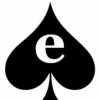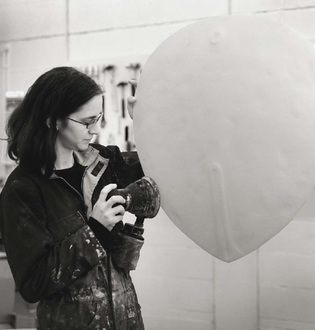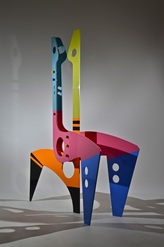| Wednesday 10th February, Guildford University http://www.briony.com/ Briony took us through a chronological journey of the evolution of her work. When Briony was 5 she wanted to be an artist. But her education and the peer pressure of seeing her friends in “proper jobs” took her to Oxford to study Biochemistry. While studying her degree she kept hearing her inner voice say “I should be in art school”. She started a life drawing class and that was the catalyst and inspiration to leave her degree and pursue an art career instead. |
Briony is interested in scientific ideas, their meaning in society and how the world works. This includes subjects such as: the boundaries of self (2 becoming one), genetic inheritance, the scientific process (of analysis), how the sum of the whole can be greater than the parts, quantum theory, nature and the structure of networks, morphic fields (Rupert Scheldrake’s hypothesis), embryonic development, emergent complexity (from nothing to something, simple elements to high complexity), and the elegance of DNA.
Early work was figurative and experimented with the boundaries of self and the loving embrace of two people. Wire and line was first explored with “Thread of Generations”, a piece about genetic inheritance. Briony made the connection at this time between the Carbon atom and the human figure, with each limb of the body representing each bond of the element of Carbon.
Wire was also used to explore the “Platonic solids” and quantum mechanical shells. She created a piece as part of her RBS Bursary award. These forms were strongly lit, casting shadows onto a wall which had writings exploring the ideas of the emergence of life on earth. Shadows and drawn lines merged.
Briony hopes that her work can be viewed without a scientific background knowledge. That perhaps it can be appreciated at a poetic or emotional level. She see science as a religion of sorts, in that it is based on a set of truths/beliefs.
Making sculpture is an expensive business, but she has had good support from foundries. When she sells work she buys more bronze which amuses her friends who would expect her to buy a new handbag.
Briony has had a couple of sculpture residencies and these where taken while pregnant with her children.
She very much enjoyed her Brian Mercer Residency in Pietrasanta, Northern Italy. (A Mecca for sculptors.) She finds that as a sculptor one gets drawn into other disciplines in order to be able to realise work. (Much like the Italian sculptors of old who got into the business of marble mining.) Here she played with hot wax in water and “exploded” the emergent shapes created with a pantograph. This process was useful for her as it allowed her to discover the joys and challenges of “editing” and evolving a larger piece of work from a smaller one.
At her Pangolin London Residency she was working with wire and embryo forms. Shadows played a key part in the work. The viewer is encouraged to explore the shadows cast by the work and then extrapolate back to understand the form that casts them. This has a strong analogy to the scientific observational process where many things cannot be directly observed but have to be inferred by observation of effects on surroundings. Taking this idea further a series of photograms were made from her work.
A particularly fascinating series of exquisite drawings and organic sculptures was created from the embryonic “Carnegie Stages”. Again the theme of emergent complexity was striking in these white bio-resin casts. Briony took us through the stages showing how a primitive line of symmetry evolves into more complex shapes. She showed us 4 “dots” which traverse the outer rim of each side of the embryo to ultimately form the 4 ventricles of the heart!
Her latest work explores molecules using the small human body sculptures culminating in a piece that recreates the double helix of DNA. A video of this work can be viewed here:
The Q&A session at the end brought up some interesting points. Though Briony feels it is important to be able to use some artistic licence in her work, she has a strong sense of scientific responsibility. Ie. To only make compromises when absolutely necessary. The scientific integrity of her work is very important as she has seen a lot of “bad science” art work.
When asked about how people should feel about her work, she says she would like to draw non-scientific people into the beauty and simplicity of science, and also help the scientific community understand and access (to them the sometimes un-engaging) world of conceptual art.
Early work was figurative and experimented with the boundaries of self and the loving embrace of two people. Wire and line was first explored with “Thread of Generations”, a piece about genetic inheritance. Briony made the connection at this time between the Carbon atom and the human figure, with each limb of the body representing each bond of the element of Carbon.
Wire was also used to explore the “Platonic solids” and quantum mechanical shells. She created a piece as part of her RBS Bursary award. These forms were strongly lit, casting shadows onto a wall which had writings exploring the ideas of the emergence of life on earth. Shadows and drawn lines merged.
Briony hopes that her work can be viewed without a scientific background knowledge. That perhaps it can be appreciated at a poetic or emotional level. She see science as a religion of sorts, in that it is based on a set of truths/beliefs.
Making sculpture is an expensive business, but she has had good support from foundries. When she sells work she buys more bronze which amuses her friends who would expect her to buy a new handbag.
Briony has had a couple of sculpture residencies and these where taken while pregnant with her children.
She very much enjoyed her Brian Mercer Residency in Pietrasanta, Northern Italy. (A Mecca for sculptors.) She finds that as a sculptor one gets drawn into other disciplines in order to be able to realise work. (Much like the Italian sculptors of old who got into the business of marble mining.) Here she played with hot wax in water and “exploded” the emergent shapes created with a pantograph. This process was useful for her as it allowed her to discover the joys and challenges of “editing” and evolving a larger piece of work from a smaller one.
At her Pangolin London Residency she was working with wire and embryo forms. Shadows played a key part in the work. The viewer is encouraged to explore the shadows cast by the work and then extrapolate back to understand the form that casts them. This has a strong analogy to the scientific observational process where many things cannot be directly observed but have to be inferred by observation of effects on surroundings. Taking this idea further a series of photograms were made from her work.
A particularly fascinating series of exquisite drawings and organic sculptures was created from the embryonic “Carnegie Stages”. Again the theme of emergent complexity was striking in these white bio-resin casts. Briony took us through the stages showing how a primitive line of symmetry evolves into more complex shapes. She showed us 4 “dots” which traverse the outer rim of each side of the embryo to ultimately form the 4 ventricles of the heart!
Her latest work explores molecules using the small human body sculptures culminating in a piece that recreates the double helix of DNA. A video of this work can be viewed here:
The Q&A session at the end brought up some interesting points. Though Briony feels it is important to be able to use some artistic licence in her work, she has a strong sense of scientific responsibility. Ie. To only make compromises when absolutely necessary. The scientific integrity of her work is very important as she has seen a lot of “bad science” art work.
When asked about how people should feel about her work, she says she would like to draw non-scientific people into the beauty and simplicity of science, and also help the scientific community understand and access (to them the sometimes un-engaging) world of conceptual art.



 RSS Feed
RSS Feed